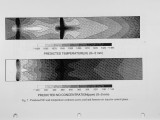| OCR Text |
maximum volatile concentration along the rebum-jet axis is higher and the volatile matter concentrated in a narrow region near to the reactor axis as a result of the impingement of the two opposing jets. This results in the overall improved performance of the four injector system. 5. Conclusions A combined experimental and theoretical approach was carried out to assess the impact of volatile release, temperature and mixing rates on N O reduction by coal reburning. Rebum performance tests using eight bituminous coals demonstrated that N O reductions of up to 6 0 % were possible depending on operating conditions and coal selection. The optimum residence time for maximum N O reduction was found to be around 450 ms for the size range of pulverised coals investigated. From a sensitivity analysis, the most important coal property was found to be the volatile matter content. The coal nitrogen content was found to be less important with regard to reducing N O in the rebum zone. The reduction of NO by hydrocarbon (CH) fragments was shown to be the dominant NO reduction route accounting for nearly 7 0 % of the total N O reduction. Higher volatile yields improved the overall N O reduction through the production of C H fragments in the rebum zone. Faster devolatilisation was also shown to be more effective for N O reduction, as a result of the earlier release of volatile gases into the surrounding primary NO-laden stream, provided that the rebum zone stoichiometry is sufficiently oxygen-lean to prevent to early oxidisation of volatile gases. Increasing the average rebum zone temperature resulted in poorer N O reduction efficiencies as a consequence of the more rapid production and consumption of hydrocarbon volatile gases before they could mix and react effectively with the primary NO-laden gases. This detrimental effect could be lessened by improving the mixing between in the rebum zone between the reburning coal jets and the primary flow. Acknowledgements The authors work like to thank the UK EPSRC for a grant in aid of this work. References 1. Chen, S. L., McCarthy, J. M., Clark, W. D., Heap, M. P., Seeker, W. R, and Pershing D. W., Twenty-first Symposium (International) on Combustion, The Combust. Institute, Pittsburgh, 1986, p.1159. 2. Wendt, J. O. L., Sternling , C. V. and Matovich, M. A., Fourteenth Symposium (International) on Combustion, p.897. The Combustion Institute, 1973. 3. Yang, Y.B., Naja, T.A., Gibbs, B. M. and Hampartsoumian, E., J. Inst. Energy, 482:9-17, (1997) 4. Liu, H., Hampartsoiirnian, E. and Gibbs, B. M , Fuel, 76:985-993 (1997) 5. Reed, R. D., Process for the Disposal of Nitrogen Oxide. John Zink Company, U.S. Patent 1,274,637, 1969. 6. Kicherer, A., Spliethoff, H., Majer, H. and Hein, K. R. G., Fuel,.73:1443-1446 (1994) 7. De Soete, G. G., Fifteenth Symposium (International) on Combustion, The Combustion Institute, Pittsburgh, 1975, pp 1093-1102. 8. Mereb, J.B. and Wendt,J. O.L., Twenty-third Symposium (International) on Combustion, The Combustion Institute, Pittsburgh, 1990, pp 1273-1279. |





















